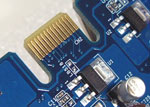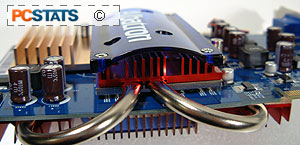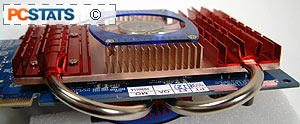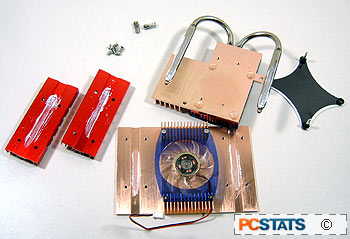 There's been a lot of focus lately on
how ATi and nVIDIA's mainstream cards only have half the rendering pipelines of
their high end counterparts. Let's remember something here though, both the NV43
and R410 have eight pixel rendering pipelines. This is the same number as on the
Radeon 9800XT, and twice that of the GeForceFX 5950 Ultra, and those cards are
still pretty darn fast. That should already tell you that performance will be
good.
There's been a lot of focus lately on
how ATi and nVIDIA's mainstream cards only have half the rendering pipelines of
their high end counterparts. Let's remember something here though, both the NV43
and R410 have eight pixel rendering pipelines. This is the same number as on the
Radeon 9800XT, and twice that of the GeForceFX 5950 Ultra, and those cards are
still pretty darn fast. That should already tell you that performance will be
good.
Nvidia's GeForce 6600 core is built on IBM's 0.11 micron manufacturing
process and contains a whopping 146 million transistors. nVIDIA has cut the
vertex pipelines from the six found in the GeForce 6800 class cards to three in
the GeForce 6600. To economize further, the memory controller has also been cut
in half to 128bit. That means at high resolutions with AA/AF enabled, the NV43
will not be able to handle things as well as its more expensive
sibling.
There are two
models of the NV43, the GeForce 6600GT and plain GeForce 6600. The Albatron Trinity
GeForce PC6600U that we're testing now is based off the Geforce 6600 and has a
core clock speed of 400 MHz, and memory running at 700MHz.

Twin Videocards with nVidia
SLI
One of the
most exciting features of the Albatron Trinity GeForce PC6600U is support for
nVidia's SLI (Scalable Link Interface, not Scan Line Interface as 3dfx called
it) technology. What this means is with a compatible motherboard, you can run
two PCI Express GeForce 6600 videocards in
parallel! In theory this will potentially double the raw rendering power of the
system.
SLI today is
different than it was back in 1998 when 3dfx released the Voodoo2. Back then,
two Voodoo2 cards would each work on half the image to be rendered. The primary
card would render all even lines of the resolution while the secondary card
would render the odd lines.
nVIDIA does
things a bit differently. One card renders the top half of the image and the
other card renders the bottom half. These cards are linked together with a
U-shaped connector that comes with the motherboard.
 At the
moment you can only SLI videocards of the same class, for example two GeForce
6600s or two GeForce 6800 Ultras, but not a 6600GT and a 6800 class card.
Whether or not you'll be able to SLI lower end cards with higher end cards in
the future is still unclear, but I wouldn't bet on it.
At the
moment you can only SLI videocards of the same class, for example two GeForce
6600s or two GeForce 6800 Ultras, but not a 6600GT and a 6800 class card.
Whether or not you'll be able to SLI lower end cards with higher end cards in
the future is still unclear, but I wouldn't bet on it.
Heatpipe technology and the passive
heatsink
The Albatron Trinity GeForce PC6600U is
one of the few mainstream-performance videocards on the market to be cooled by
heatpipe technology. Before we look closely at the cooler on this videocard,
let's talk a bit about heatpipes in general.
 A heatpipe
is sealed copper tube which absorbs heat from one side (the source) and moves it
to another location in an effort to cool off the source. The thermal transfer is
achieved thanks to a working fluid (usually water) that is vacuum sealed inside
a copper tube.
A heatpipe
is sealed copper tube which absorbs heat from one side (the source) and moves it
to another location in an effort to cool off the source. The thermal transfer is
achieved thanks to a working fluid (usually water) that is vacuum sealed inside
a copper tube.
With a lower
atmospheric pressure inside the tube, the working fluid will become vapour at a much lower
temperature if one side of the heatpipe is heated. This is plain old physics at
work - the lower the air pressure, the lower the temperature needed to boil water.
When one end of the copper heatpipe starts warming up by the heat of the GPU,
the working fluid inside the heatpipe will absorb that heat energy and convert from
liquid to vapour.
 As the working fluid changes phases,
it absorbs the latent heat energy and carries it towards the
cooler end of the heatpipe. Once the vapour reaches the cooler side, it
releases its heat energy into the copper tube, and consequently condenses back into liquid
form.
As the working fluid changes phases,
it absorbs the latent heat energy and carries it towards the
cooler end of the heatpipe. Once the vapour reaches the cooler side, it
releases its heat energy into the copper tube, and consequently condenses back into liquid
form.
The cooler end of the heatpipe is connected to
a standard heatsink, which then transfers the heat it has absorbed from the
heatpipe into the surrounding environment (air). The newly condensed working
fluid is then drawn by capillary action through an internal wick structure
inside of the heatpipe back towards the hot end, and the entire process repeats
itself.
This system
seems to work extremely well with the Albatron Trinity GeForce PC6600U. The
heatsink on the rear of the card was often as hot as the heatsink on the front
where the VPU is, and the small rear fan enables the card to quickly release the
waste heat.
